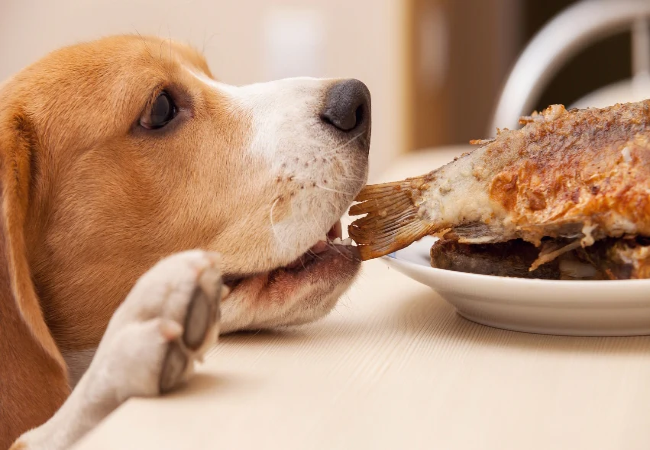Veterinary Guide to High Cholesterol in Dogs 2025 ⚕️🐶

In this article
Veterinary Guide to High Cholesterol in Dogs 2025 ⚕️🐶
By Dr. Duncan Houston BVSc
🧬 What Is High Cholesterol in Dogs?
High cholesterol—also called hyperlipidemia—is when both cholesterol and triglyceride levels stay abnormally elevated in the bloodstream, even after a 12 hr fast. Normal cholesterol ranges between ~120–270 mg/dL; levels above this are considered high.
🚨 Causes: Why It Happens
- Transient: a high-fat meal—levels usually return to normal in 7–12 hrs.
- Secondary: endocrine disease (hypothyroidism, Cushing’s, diabetes), pancreatitis, obesity, kidney disease, and meds like steroids.
- Primary (idiopathic/genetic): common in Miniature Schnauzers, Beagles, Shelties, Poodles; often due to lipoprotein lipase deficiencies.
👀 Clinical Signs & Risks
Often asymptomatic—but watch for:
- Fatty eye changes (corneal/cloudy white spots).
- GI distress—vomiting, diarrhea, abdominal pain.
- Increased risk of pancreatitis and seizures with high triglycerides.
- Skin issues—itching, xanthomas, hair loss.
- Neurological signs when lipids are present.
🔬 Diagnosing High Cholesterol
- Fasted blood lipid panel after 12 hours.
- Repeat the test if elevated.
- Full diagnostic work-up: CBC, chem, thyroid, endocrine tests, pancreatitis panel, urinalysis—rule out secondary disease.
- Lipoprotein analysis or lipase activity testing for primary cases.
🥗 Treatment & Management
1. Dietary Therapy
- Prescribe low-fat diets (<20% fat ME; ultra-low <1–4 g/100 kcal).
- High-fiber soluble ingredients help lower cholesterol absorption.
- Avoid treats/table scraps; home-cooked diets are possible via vets/nutritionists.
2. Underlying Disease Management
Treating hypothyroidism, diabetes, Cushing’s, pancreatitis, etc., often lowers lipid levels spontaneously.
3. Supplements & Medications
- Omega‑3 fish oil: 200 mg/kg/day reduces triglycerides & cholesterol.
- Niacin or chitosan: B-vitamin or fiber supplement; limited evidence, potential side effects.
- Fibrates (gemfibrozil, fenofibrate): normalize triglycerides in ~86–100%; fenofibrate is often most effective.
- Statins or bile acid sequestrants: reserved for severe hypercholesterolemia (>750 mg/dL); monitor liver/muscle enzymes.
📈 Monitoring & Prognosis
- Recheck fasted lipids at 4–8 weeks post-diet change.
- If medications are used, follow up every 1–3 months with panel, liver & muscle labs.
- Manage secondary disease for long-term control.
- With a dedicated diet, management, and meds, most dogs do well long-term. Primary cases require lifelong commitment.
📋 At‑Home Owner Tips
- Always feed a 12 hr fast before lipid tests; no treats allowed before test sampling.
- Consistency: same diet, portions, and feeding times daily.
- Exercise: regular low-impact activity to support metabolism.
- Track appetite, energy, GI health, seizures;
- Use non-slip surfaces and home calm areas if neurologic signs appear.
- Keep emergency medications (e.g., for a pancreatitis flare) ready.
📱 Ask A Vet Ecosystem Integration
- Telehealth follow-up: monitoring lipid results, adjusting diet/meds remotely.
- Assist with obtaining and learning to administer home blood/lipid tests.
📚 Real‑World Case: “Max” the Miniature Schnauzer
“Max,” an 8‑year‑old Schnauzer, was diagnosed with triglyceride = 900 mg/dL and cholesterol = 500 mg/dL. On a low-fat prescription diet, omega-3, and fenofibrate, lipids normalized (<300/200 mg/dL) over six weeks. Pancreatitis signs resolved. Six‑month follow-up shows continued stability on diet + fish oil, medication tapered. Owner reports, “Max is back to chasing leaves and feeling his old self!” 🐾
🔚 Final Takeaways
- High cholesterol (>270 mg/dL) needs investigation—fasted repeat & full work-up.
- Address secondary diseases—often resolves hyperlipidemia.
- Low-fat/fiber-rich diets are cornerstone therapy; may need meds in severe cases.
- Regular monitoring with diet or med changes is crucial.
- With proper care, most dogs live happily, even long-term.
Dr Duncan Houston BVSc, Ask A Vet founder. Download the Ask A Vet app for continuous support in lipid management—your dog deserves healthy longevity! 🐶❤️.






